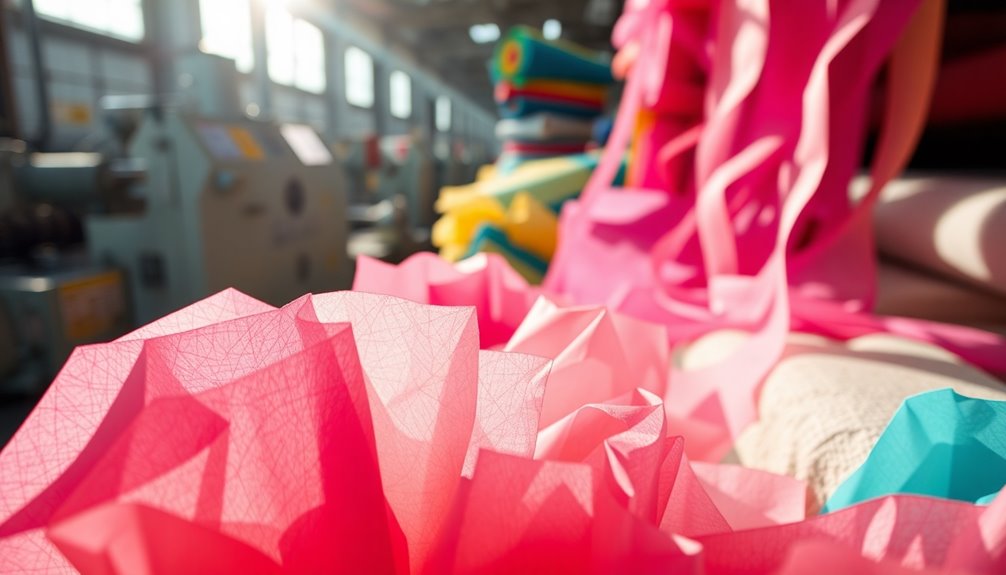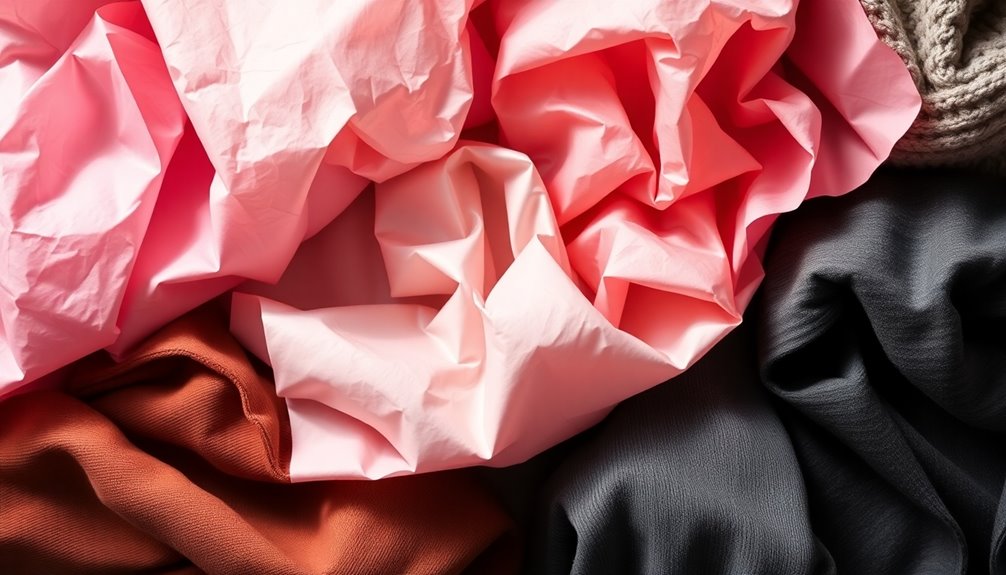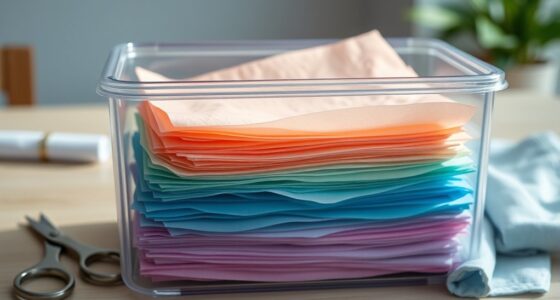Tissue paper's composition might surprise you. It's mainly made from paper pulp derived from wood fibers. Advanced machinery, like Yankee dryers, turns this pulp into the soft, absorbent product you use daily. The Through-Air Dried process enhances its absorbency by creating a porous structure. While most tissue paper is two-ply with a lightweight basis of 20-24 g/m², sustainable initiatives are at play too. Nearly half of all raw materials come from recovered fibers to reduce tree consumption. Curious about other innovative processes and eco-friendly practices behind this everyday item? You'll find more fascinating details ahead.
Key Takeaways
- Tissue paper is primarily produced from paper pulp derived from wood fibers, enhancing its absorbency and strength.
- The Through-Air Dried (TAD) process creates a porous structure, significantly improving water absorption properties.
- Advanced machinery, including Yankee dryers, plays a crucial role in the effective drying of tissue paper.
- Approximately 46.5% of raw materials in tissue production now come from recovered fibers, promoting sustainability.
- Innovative recycling technologies are enhancing the quality of recycled tissue paper, reducing tree consumption significantly.
Unveiling Tissue Paper Secrets

When you think about tissue paper, you might not realize just how intricate its production process is. At the heart of this process is paper pulp, which is derived from wood fibers. The paper pulp undergoes a meticulous transformation through advanced machinery, ensuring that the final product meets specific requirements for absorbency and softness. This is crucial, especially for products like toilet paper and facial tissues that demand effective moisture management.
Since industrial production began in the 1940s, the methods for creating tissue paper have evolved significantly. Innovations, such as the Through-Air Dried (TAD) process, have greatly enhanced water absorption capabilities, making tissue paper more effective in its hygienic applications.
However, environmental concerns loom large. The industry estimates that around 270,000 trees are flushed down the toilet every day due to toilet paper usage. To combat this, manufacturers are increasingly incorporating recovered fibers into production, which now make up 46.5% of raw materials. This shift not only addresses ecological issues but also aligns with the growing global market for tissue paper, valued at around 10 billion Euros in Europe alone.
Composition and Manufacturing Process

The composition and manufacturing process of tissue paper are fascinatingly intricate, reflecting a blend of natural materials and advanced technology. Tissue paper is primarily made from paper pulp, which comes from wood fibers. The manufacturing process begins with these fibers, which are processed using a paper machine equipped with a Yankee dryer to dry the sheets effectively.
During production, the creping process enhances the flexibility and softness of tissue paper. This is controlled by the adhesive strength and the geometry of the doctor blade used, ensuring a soft texture. To improve absorbency, manufacturers often utilize the Through-Air Dried (TAD) process. This technique allows hot air to flow through the wet sheet, creating a more porous structure that enhances performance.
Typically, tissue papers have a basis weight ranging from 20 to 24 g/m², which affects their strength and absorbency. Additionally, the quality of the pulp and any additives used significantly impact the final properties of tissue paper. These factors are crucial, especially in hygienic applications where wet strength and overall performance are essential. So, next time you use tissue paper, remember the complex process that shaped it!
DIY Gift Wrapping Ideas

Tissue paper isn't just for wiping; it's a versatile material perfect for adding a personal touch to your gift wrapping. You can layer different colors and patterns of tissue paper to create a visually appealing package that stands out. Consider making tissue paper pom-poms or flowers as decorative elements. Simply fold and cut the tissue into petal shapes, and attach them to your gift for a charming effect.
For a sustainable twist, repurpose used tissue paper from previous gifts. Smooth it out, and you'll find it still looks great! You can also use tissue paper to fill a gift bag, providing cushioning and a pop of color that enhances your presentation.
If you want to get even more creative, try decoupage techniques. Use printed tissue paper to cover boxes or containers, transforming them into customized gift packaging that reflects the recipient's personality. With these DIY gift wrapping ideas, you'll not only impress your friends and family but also enjoy the process of creating something unique with tissue paper. So grab some tissue paper and start wrapping!
Environmental Impact Discussions

Many people don't realize the environmental impact of tissue paper production and consumption. The WWF estimates that a staggering 270,000 trees are flushed daily, with around 10% of that attributed to toilet paper. This deforestation poses significant concerns for our ecosystems. However, the tissue paper industry is making strides toward sustainability. Did you know that 46.5% of raw materials now come from recovered fibers? This shift helps to reduce reliance on virgin pulp, showing a heart made of tissue that cares for the environment.
Recent advancements in production processes have also led to impressive reductions in energy use and emissions. Specifically, there's been a 16% drop in primary energy consumption and a 25% decrease in carbon dioxide emissions from fossil fuels. Eco-labels like the EU Flower and Forest Stewardship Council standards are becoming more common, promoting sustainable forestry practices and environmentally friendly production.
Despite these improvements, reports like the 2019 NRDC and Stand.earth reveal that major tissue brands still fall short on using recycled content. This highlights the need for greater accountability and transparency in the industry. It's essential to support brands that prioritize our planet's health.
Innovative Tissue Recycling Programs

Innovative recycling programs are transforming the tissue paper industry, making it more sustainable than ever. You'll find that many manufacturers are now utilizing recovered fibers, which account for 46.5% of the raw materials used in the paper industry. This shift significantly reduces environmental impact. With closed-loop systems in place, companies can recycle used tissue products into new ones, greatly contributing to sustainability efforts.
These tissue recycling initiatives are also addressing pressing environmental concerns, aiming to minimize tree consumption. It's staggering to think that around 270,000 trees are flushed down due to toilet paper usage each day. By adopting advanced recycling technologies, the industry is improving the quality of recycled tissue paper. This means you can enjoy products made from post-consumer waste without compromising performance or hygiene standards.
Moreover, eco-labels and standards, like those from the Forest Stewardship Council, encourage tissue companies to source raw materials responsibly. This shift not only promotes sustainability but also assures you that the products you use are environmentally friendly. As you choose tissue paper, you can now feel good knowing that innovative recycling programs are paving the way for a greener future. Additionally, many companies are exploring tax-deferred growth options to further invest in sustainable practices.
Key Tissue Paper Insights

A wealth of insights about tissue paper reveals its vital role in everyday life and the industry's commitment to sustainability. You might be surprised to learn that tissue paper is primarily made from paper pulp, which undergoes a creping process that boosts its absorbency and strength. The TAD (Through-Air Dried) process takes it a step further, enhancing water absorption properties.
Most consumer tissue products are designed to be two-ply, with a basis weight ranging from 20-24 g/m², ensuring added durability for your daily needs. Sustainability is a growing focus, with around 46.5% of raw materials in the paper industry sourced from recovered fibers. This shift reflects a wider trend towards eco-friendly practices.
The global tissue paper market is booming, producing an impressive 21 million tonnes, with Europe alone contributing about 6 million tonnes valued at roughly 10 billion Euros. Environmental initiatives are actively underway to mitigate the impact of toilet paper usage, emphasizing recycling, sustainable forestry practices, and adherence to eco-label standards. These key insights underscore how tissue paper not only serves practical purposes but also aligns with environmental stewardship.
Frequently Asked Questions
What Material Is Tissue Paper Made Of?
Tissue paper's mainly made from paper pulp, which comes from wood fibers. You might find it contains both virgin and recycled materials, enhancing its sustainability. The production process uses techniques like Yankee drying and controlled creping to improve absorbency and strength. Its low basis weight, typically between 20 to 24 g/m², gives it that soft feel. Furthermore, higher-quality pulp and additives boost wet strength, making it ideal for hygienic uses.
What Is the Ingredient of Tissue Paper?
The main ingredient of tissue paper is paper pulp, which comes from wood fibers. You'll find that many manufacturers use sustainable forestry practices to source this pulp. Sometimes, they add materials to improve the paper's strength and absorbency. Creping techniques also play a role in the texture and performance of tissue paper. Additionally, the industry increasingly uses recovered fibers to reduce environmental impact, making tissue paper more sustainable.
What Chemicals Are in Tissue Paper?
When you think about tissue paper, you might not realize the chemicals involved in its production. Sodium hydroxide helps with pulping, while bleaching agents like chlorine dioxide lighten the fibers. To improve durability, manufacturers often add wet strength agents like polyvinyl alcohol. You'll also find sizing agents such as starch, which enhance absorbency. Lastly, dyes and fragrances can be included for aesthetic appeal, though they're regulated for safety.
What Tree Is Tissue Paper Made From?
Tissue paper is primarily made from wood pulp, mainly derived from softwood trees like pine, spruce, and fir. These trees are chosen for their long fibers, which enhance strength and absorbency. When you use tissue paper, you're likely using a product made from these specific trees. However, the industry is increasingly incorporating recycled fibers and alternative materials, like bamboo, to reduce environmental impact and promote sustainability in paper production.










